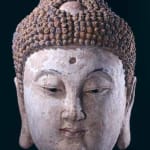Yuan Painted Terracotta Head of the Buddha, 1279 CE - 1368 CE
Painted Terracotta
13
H.693
The Yuan Dynasty was established by Kublai Khan, the grandson of Genghis Khan, upon relocating the capital of his empire from Mongolia to Beijing. The Forbidden City was constructed, a...
The Yuan Dynasty was established by Kublai Khan, the grandson of Genghis Khan, upon relocating the capital of his empire from Mongolia to Beijing. The Forbidden City was constructed, a relative oasis of Mongolian culture in the heart of China. While the Mongol elite retained their native language and customs, they did adapt the Chinese system of bureaucratic government and cemented the authoritarian rule of the emperor. Although they were unaffected by Chinese culture, the Yuan did little to stifle the native traditions and beliefs of their subjects. Buddhism continued to flourish, although the monasteries received little funding from the state. In fact, during the Yuan Dynasty, China first began to open up to foreigners. Christian and Hindu missionaries were established in Beijing and Marco Polo made his famous journey during the Yuan era. While the Chinese never accepted the Yuan as a legitimate dynasty, instead viewing them as foreign bandits, the Mongolians rebelled against the Beijing Khans for becoming, “too Chinese.” In the end, the Yuan Dynasty had the shortest duration of the major Chinese Dynasties, lasting little more than a hundred years.
The historical figure, Buddha Gautama Sakyamuni is the Buddha of compassion who, having achieved the highest evolutionary perfection, turns suffering into happiness for all living beings. Born around 560 B.C. somewhere between the hills of south Nepal and the Rapti river, his father was a Raja who ruled over the northeastern province of India, the district including the holy Ganges River. The young prince was married to Yashoda when he was about 17 years old and together they had a son named Rahula. At the age of 29, he left his life of luxury, feeling compelled to purify his body and make it an instrument of the mind by ridding himself of earthly impulses and temptations. Chinese Buddhist art is heavily influenced both by earlier Indian examples and the stylistic tendencies of the Central Asian cultures who brought the religion into China.
Here, the Buddha is portrayed as a youthful prince with a round, full face, suggestive of his spiritual fullness and inner self-satisfaction. An inner calm and complacency is visible on his face and in his sweet smile. Tight curls of hair cover his head and ushnisha, the symbol of his infinite wisdom. His elongated earlobes droop down, the sagging caused by wearing heavy earrings as an infant, reflecting his royal origins. The urna, or “third eye,” is represented by a small bump in between his eyebrows, is also symbolic of his nobility and enlightenment. This fragment of a head was most likely originally part of a full-figured sculpture that once revered inside a temple or shrine. He appears to look down upon us with his inlaid eyes, suggesting that the work might have been raised upon a pedestal structure. The mystical energy and divine wisdom of the Buddha radiates from within this sculpture. The contemplative wisdom of the Buddha shines through the stucco and warms our spirits.
The historical figure, Buddha Gautama Sakyamuni is the Buddha of compassion who, having achieved the highest evolutionary perfection, turns suffering into happiness for all living beings. Born around 560 B.C. somewhere between the hills of south Nepal and the Rapti river, his father was a Raja who ruled over the northeastern province of India, the district including the holy Ganges River. The young prince was married to Yashoda when he was about 17 years old and together they had a son named Rahula. At the age of 29, he left his life of luxury, feeling compelled to purify his body and make it an instrument of the mind by ridding himself of earthly impulses and temptations. Chinese Buddhist art is heavily influenced both by earlier Indian examples and the stylistic tendencies of the Central Asian cultures who brought the religion into China.
Here, the Buddha is portrayed as a youthful prince with a round, full face, suggestive of his spiritual fullness and inner self-satisfaction. An inner calm and complacency is visible on his face and in his sweet smile. Tight curls of hair cover his head and ushnisha, the symbol of his infinite wisdom. His elongated earlobes droop down, the sagging caused by wearing heavy earrings as an infant, reflecting his royal origins. The urna, or “third eye,” is represented by a small bump in between his eyebrows, is also symbolic of his nobility and enlightenment. This fragment of a head was most likely originally part of a full-figured sculpture that once revered inside a temple or shrine. He appears to look down upon us with his inlaid eyes, suggesting that the work might have been raised upon a pedestal structure. The mystical energy and divine wisdom of the Buddha radiates from within this sculpture. The contemplative wisdom of the Buddha shines through the stucco and warms our spirits.



